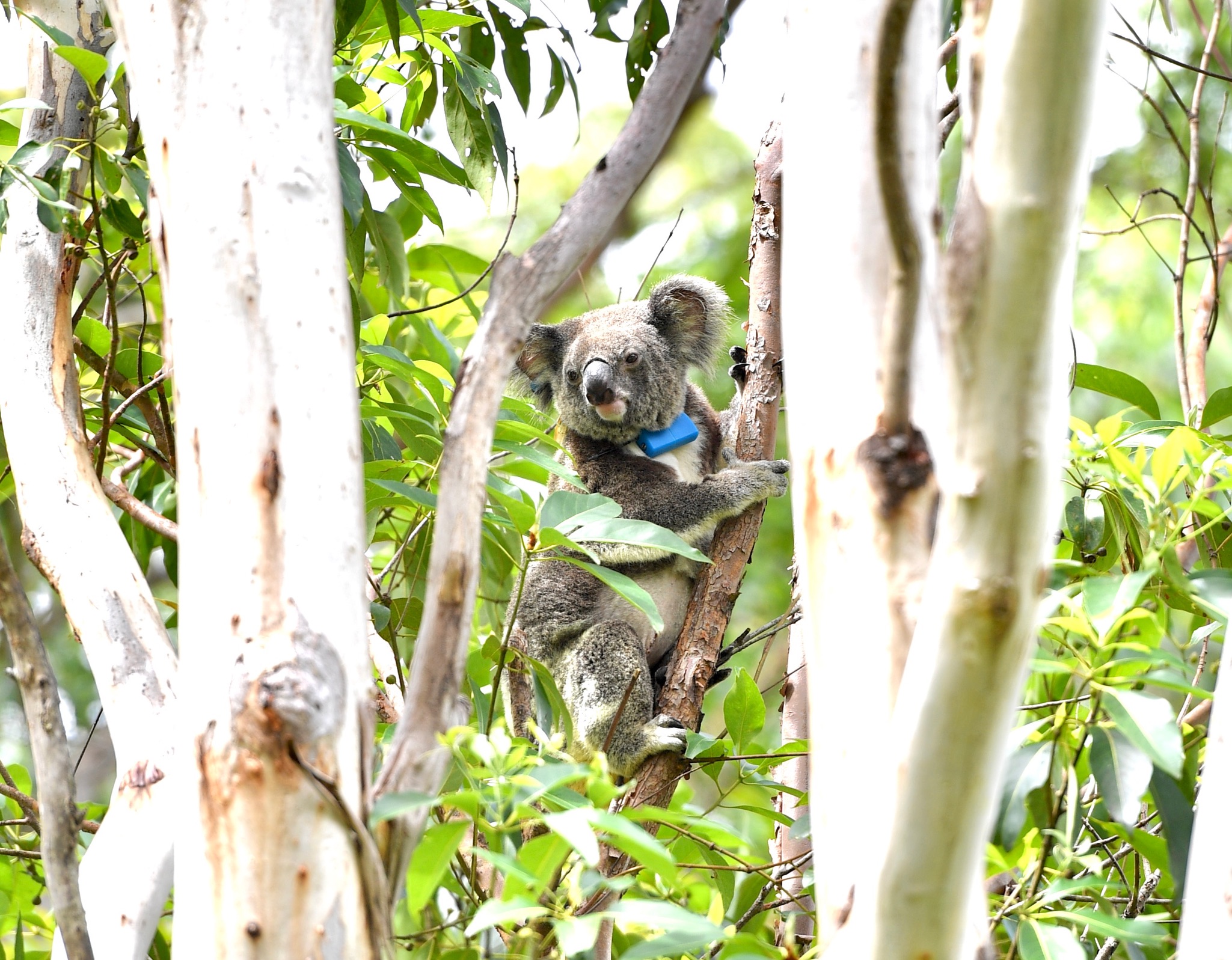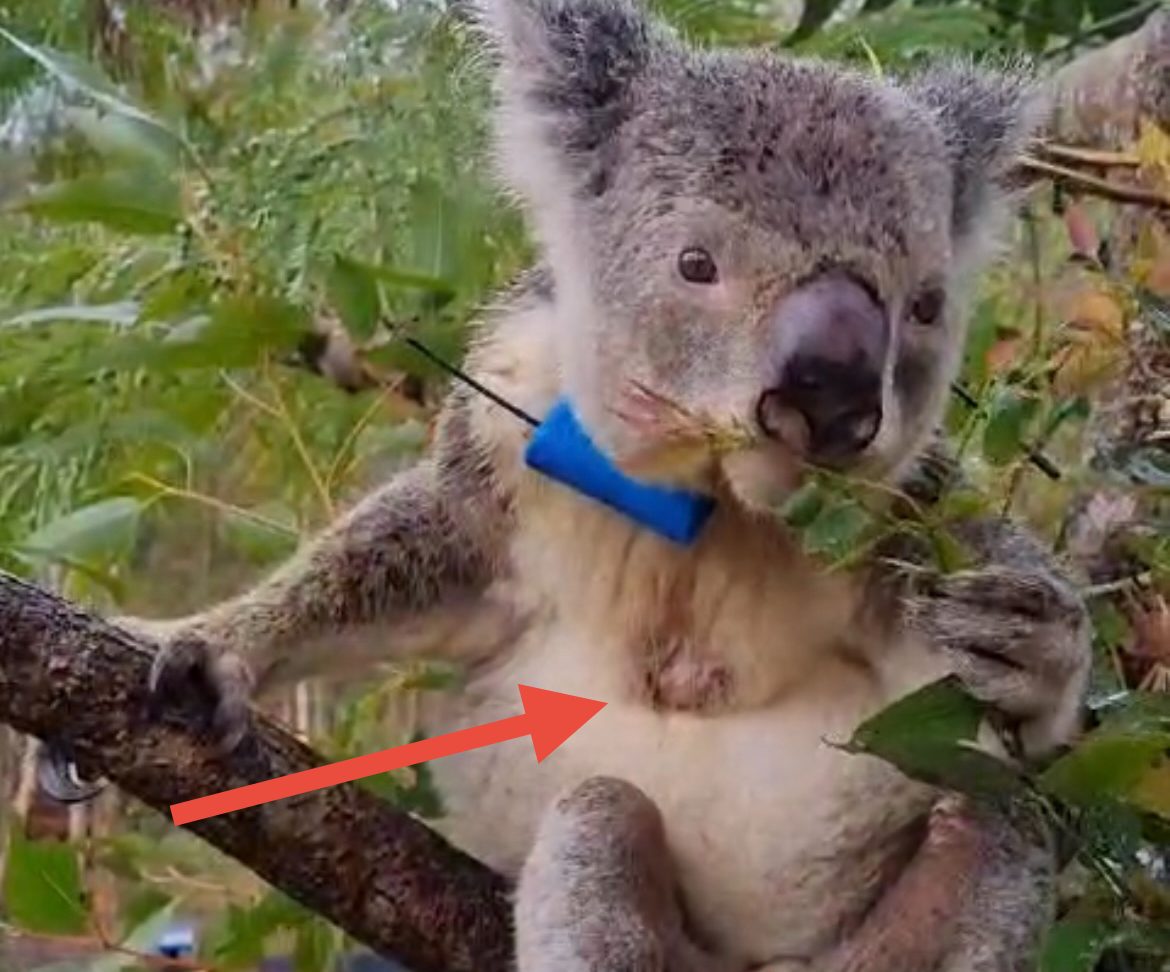


Why do koalas get tagged?
GPS and VHF monitoring tags allow us to keep koalas safe during clearing of vegetation. We can also treat them promptly when they get sick.
Are koalas tagged just for scientific research?
No. We primarily use GPS and VHF tags to protect them during vegetation clearing, and to help us to detect when they are at risk, sick or injured.
Why do you put collars on the koalas?
Koalas are collared to keep them safe from being killed or injured during vegetation clearing. Without collars, around 50% or more would not be seen until it was too late. Koalas and other wildlife suffer horrific injuries and agonising deaths if they are not moved or avoided during vegetation clearing. One of the most upsetting and poignant cases we saw, as wildlife veterinarians working at a hospital, was a mother koala, still conscious and very alive, clutching her 8-month-old joey to her chest with her left arm. Her right arm had been torn off above the elbow during vegetation clearing. These are the sorts of injuries we’re doing our best to avoid.
How does a GPS collar stop a koala getting hit by a car or drowned in a pool?
It doesn’t prevent every incident. These are still wild koalas living in the wild and despite our best efforts we cannot keep all of them safe, all of the time. We do our best though and often get help from wildlife rescuers and members of the community.
We cannot be with the koalas 24 hours a day; they need to be able to “do what they do” on a day-to-day basis. Sadly, our environment is becoming more developed – and safe habitat for wildlife is reducing. Our team has saved the lives of many koalas – we often intervene but sometimes we can’t.
Can the collars prevent bad incidents from occurring?
In many cases the collars enable us to respond quickly when a koala is in danger. For example, if a koala’s GPS location suddenly appears in a rail corridor, our team checks on the koala as soon as possible for potential rescue. However, while we are often able to intervene in these types of situations, unfortunately, we cannot always get there in time.
The collars also monitor activity levels. If we notice a zero activity reading or a downward trend in their activity, they are tracked as a priority, allowing us to capture and treat many sick or injured koalas, saving many lives. Sadly, some koalas may be too ill to treat (e.g. cancers), and euthanasia is performed on humane grounds. This ensures the koala’s suffering is alleviated, a more compassionate outcome than letting it suffer in the wild.
If they have a collar, why do they need additional tags?
Our koala collars are very safe – they will break if a koala gets them caught on something. This happens quite a lot. Having a back-up tracker (a small VHF beacon) allows us to find the koala again and replace the collar. Remember – without that collar, it is impossible for us to monitor the koala effectively during high-risk periods.
Is a tracker implanted under the koala’s skin?
No. A small back-up VHF beacon is glued to the fur on the back and secured by surgical sutures under general anaesthesia. This is very safe and does not affect the koala’s behaviour or a joey that might be riding on a mother koala’s back.
Is it painful or uncomfortable for a koala to have tags fitted?
Most tagging and veterinary health assessments are conducted while the koala is under deep sedation – they don’t feel anything. It is very common for koalas to start eating leaves as soon as they wake up. If they felt significant pain or discomfort, they would not do this.
Don’t collars and other tags restrict their movement and feeding and other behaviour?
No. We’ve made several important modifications to the usual koala collars that were used for decades, to make them much safer, more comfortable, and less restrictive for koalas. All of the koalas we monitor show normal behaviour and ranging – unless they’re sick!
Aren’t low impact ‘non-invasive’ methods better for monitoring koalas?
That depends on what the objective is. Methods that don’t use tracking collars don’t allow koalas to be located efficiently or quickly and avoided during vegetation clearing – a really serious risk to them. They also don’t allow for rapid detection of injury, illness or death – but that’s because they are not designed to do those things. They are good for surveying for koala presence, estimating numbers, even estimating disease rates – but not really for keeping koalas safe during risky periods.
Why did you develop the K-tracker in the first place?
Previously it was almost impossible to identify all koalas that were in harm’s way when land clearing or construction was imminent. There was no way to have eyes on all koalas and we had seen on other projects the atrocities of koalas being knocked out of trees, suffering major trauma or death as a direct result. It was probably the most critical thing we wanted to address. From that basis we then developed a technology that not only helps us know where they are, where they’ve been but also if they’re in good health. It’s been a game-changer, and our results prove this. At the same time, we made the collars a lot safer and more comfortable for the koalas wearing them.
Do your collars sit over the scent gland of the males?
As demonstrated in the photo, the blue housing of the collar is usually positioned well above the scent gland. Just like humans, koalas have different body shapes—some are more slender, others more stocky—so the fit can vary from one animal to another. Some koalas have a small, barely visible scent gland, while others have a larger, more prominent one that may appear stained.

Do these trackers stay on forever?
No. They will be on for the duration of the development project. Generally, they won’t be taken off until the major risks associated with a project have been managed.
Why do you support developments which threaten koala habitat?
We don’t. However, if a development has been approved by the local, state and/or federal governments, and it will become a reality, we would prefer to be appointed to minimise the risk to koalas. We tend to only work on projects in which the client has a vested interest in the appropriate management of the environment – otherwise it would be unworkable.
If we are to work on a project we will not compromise on the quality of the care and support – we are driven to achieve good outcomes and soften the development impacts.
Why do you work on projects that are clearing koala habitat?
If we don’t, who will? These projects are often approved before we get involved, but not always. We usually can’t change the decisions that governments make to approve new roads, mines and urban developments. The most important thing we can do is to help protect and conserve the koalas in the best way we know how – and we strive to constantly improve.
Does what you do even make a difference?
It really does: for the individuals we help when they are suffering – animals that are suffering chronic, painful and debilitating illnesses, like chlamydial disease – the treatment and relief of that suffering is what matters to them; for the populations in decline, that we’ve helped to become healthy again – these things matter and the benefits are real, measurable and durable. What we do also lifts the benchmark standard – in the hope that each subsequent development does things better.
How do you justify what you do?
Every day our team is committed to achieving the best results for the koalas in our care. Every koala is given a name. We get to know them, where they go, what their favourite tree is, when they are sick and when they may be in harm’s way. Every field event is recorded, and we now have, arguably, the largest database of koala health and activity.
But the real justification is in the measurable outcomes. Zero deaths from land clearing and construction; reversal of likely localised extinction; treatment of chlamydial infection and disease to address population decline and animal welfare issues – an increase in koala numbers but, as importantly, an improvement on the health of each animal. We have real numbers, real data, and mapping that validates these achievements.
We are also able to demonstrate that projects that had been completed years ago have been naturally maintained and improved – in some cases the doubling of the koala population. These populations are viable and healthy – proving the durable benefits of these comprehensive management programs.
Permits and Ethics Approvals:
All work with koalas conducted by EVE is carefully planned, documented and approved by an Animal Ethics Committee (AEC). In addition, all of our work with koalas is conducted under a research permit issued by the Queensland Government’s Department of the Environment, Tourism, Science and Innovation (DETSI). EVE also abides by all conditions and approvals where required by the federal Department of Climate Change, Energy, the Environment and Water (DCCEEW).

